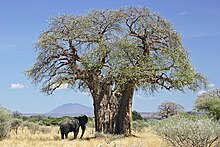African baobab
| Adansonia digitata | |
|---|---|
 |
|
| Baobab tree in Tanzania | |
| Scientific classification | |
| Kingdom: | Plantae |
| (unranked): | Angiosperms |
| (unranked): | Eudicots |
| (unranked): | Rosids |
| Order: | Malvales |
| Family: | Malvaceae |
| Genus: | Adansonia |
| Species: | A. digitata |
| Binomial name | |
|
Adansonia digitata L. |
|
| Synonyms | |
|
|
Adansonia digitata (baobab) is the most widespread of the Adansonia species, and is native to the African continent. The long-lived pachycauls are typically found in dry, hot savannahs of sub-Saharan Africa, where they dominate the landscape, and reveal the presence of a watercourse from afar. Their growth rate is determined by ground water or rainfall, and their maximum age, which is subject to much conjecture, seems to be in the order of 1,500 years. They have traditionally been valued as sources of food, water, health remedies or places of shelter and are steeped in legend and superstition. European explorers of old were inclined to carve their names on baobabs, and many are defaced by modern graffiti. Common names for the baobab include dead-rat tree (from the appearance of the fruit), monkey-bread tree (the soft, dry fruit is edible), upside-down tree (the sparse branches resemble roots) and cream of tartar tree (cream of tartar).
The vernacular name "baobab" is derived from Arabic بو حِباب (būħibāb), which means "father of many seeds". The scientific name Adansonia refers to the French explorer and botanist, Michel Adanson (1727–1806), who observed a specimen in 1749 on the island of Sor, Senegal. On the nearby Îles des Madeleines Adanson found another baobab, 3.8 m in diameter, which bore the carvings of passing mariners on its trunk, including those of Henry the Navigator in 1444 and André Thevet in 1555. When Théodore Monod searched the island in the 20th century, the tree was not to be found however. Adanson concluded that the baobab, of all the trees he studied, “is probably the most useful tree in all.” He consumed baobab juice twice a day, while in Africa. He remained convinced that it maintained his health for him. "Digitata" refers to the digits of the hand. The baobab's compound leaves with normally five (but up to seven) leaflets are akin to a hand.
...
Wikipedia
